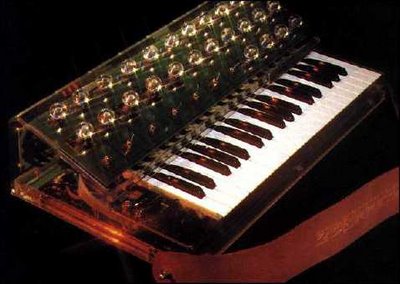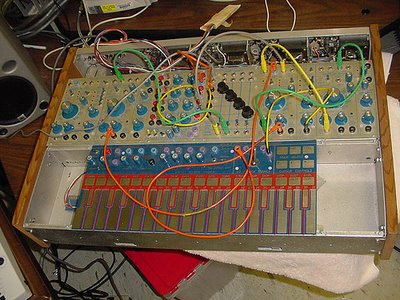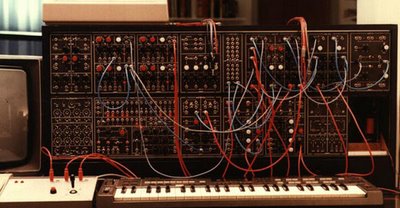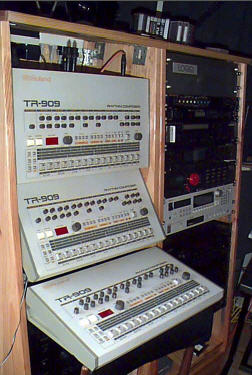 Click here
Click here for shots via
this auction.
Details:
"Only 50 ever made - so this is probably the last time you will see one again - this rare beast sounds like a cross between Moog / Oberheim and the Prophet synths and the has the film soundtrack fx side of the VCS3 so is killer for film soundtracks - the Gleeman is in tip top condition and has been recently serviced by a reputable UK company - it comes with mains 110>240v transformer - the total shipping weight is 26kg so email me your area/postal code / country for shipping quotations - I originally paid £2000.00 for the Gleeman Pentaphonic - remember this is one of the very rarest synths out there - you will definately not see another one and it sounds like no other - here is what has been said of the legendary Gleeman Pentaphonic:
The Gleeman Pentaphonic
by Joey Swails (j.swails@comcast.net)
The Gleeman Pentaphonic was introduced in 1981 by the Gleeman company, a partnership of two brothers, Bob and Al Gleeman. They were based (in the grand old Silicon Valley tradition) in their garage in Mountain View, California.
I met Bob Gleeman at the 1982 AES show in Anaheim, while I worked for Don Wehr's Music City in San Francisco. I was blown away by the Pentaphonic's sound; Bob came around the store a soon after, and we became the first authorized Gleeman dealer.
The story goes that the Pentaphonic came about when Bob decided that he wanted a synthesizer like a Prophet-5, but smaller and more portable. His "smarter brother" Al, a computer hardware designer, basically designed the synth from the ground up, working from his brother's description of what a polyphonic synthesizer should do.
It was in actually a digital/analog hybrid -- the filters and amps were based on the same Curtis chips that were used in the Prophet, ARP and Octave machines. The oscillators were digital, as were the ADSRs. The machine was based on the Intel 80186 microprocessor, which was very advanced for it's time. In fact, it used two 80186's -- one for the keyboard/transpose functions, the other for waveform and amplitude control. One thing led to another and they decided to try to market the machine after everyone who heard it told them how great it sounded. They had wanted to call it the "Gleeman Minstrel", since their family name Gleeman means "minstrel." But there was another machine on the market called Minstrel (the Basyn, by Grey Labs), so they settled on "Pentaphonic".
The oscillator section featured 3 oscillators, each with a selection of 8 waveforms. The waveshapes were fixed, in that there was no pulse-width modulation. Instead it offered 3 choices of pulse widths. There were two "digital" waveforms with lots of high, bell-like overtones which had a distinctive, almost FM-like sound when selected.
There was an octave switch on each oscillator (hi/low) and a "chorus" switch that actually detuned oscillators 2 and 3. Interval tuning of the oscillators was not introduced until the programmable version was made, and the intervals were part of the program, selected by pressing keys on the keyboard. There was also a Transpose control that shifted the entire tuning of the machine in half-steps over a one octave range.
It was a standard Prophet-type control set, with one filter ADSR and one volume ADSR. The filter section had the standard cutoff, contour amount and resonance dials. The layout was basically that of a MiniMoog, including an oscillator mixer that included a pink noise control.
One drawback was a lack of a keyboard tracking filter setting, which was explained to e as being impossible due to the way the keyboard controlled the oscillators. Another as that it also lacked a provision for a sustain pedal.
The keyboard system was unique in that it was not based on the same serial-scanning system developed by Tom Oberhiem used by virtually every polyphonic synth, but was rather a parallel port that had an input point for each of the 37 keys. This made for a very fast, responsive keyboard, but made it difficult to derive an analog voltage
to use for filter tracking.
The first Pentaphonic's joystick was only a pitch bend lever, but later they upgraded it to allow for pitch bending and modulation of either the pitch or filter cutoff. There was also a simple, real time, one-track sequencer built in, but with the unique eature of being able to play back the sequence while playing the keyboard with the joystick and transpose control effecting only the notes played on the keyboard.
The original Gleeman Pentaphonic retailed for US$2795 and featured a 6X9 inch "car speaker" with amplifier built into the back of the cabinet. The price included an injection molded road case (actually a Samsonite suitcase customized with form-fit molding inside to hold the synth and a "Gleeman" nameplate glued over the "Samsonite" label.)
In 1982, the programmable version was introduced. I had told Bob from the beginning how much better (and more marketable) the Pentaphonic would be if it were programmable (as the Prophet-5 was setting the standard for analog synths in these days.) The "Presetter" used a two-digit thumbwheel selector next to the joystick with a toggle switch. The first 50 programs (designed by the Gleemans with help from
myself and Keith Hildebrant, who later worked for Opcode and authored several sound sample disks) were in ROM memory and the second 50 were user programmable. The toggle switch allowed for either instant recall as the thumbwheels were changed, or in the second position the patch remained in performance memory until the wheels were changed and the switch was toggled into the "recall" position. A small recessed red
button was the "write" switch. Unfortunately there was no provision for off-loading of programs. The programmable version retailed for US$3295.
I sold Oscar Petersen his Pentaphonic a few months after we became a dealer. He was playing a concert in town nearby and came into the store just to kill time after the soundcheck. He started playing on the Pentaphonic and didn't stop for two hours, while a small crowd gather to listen. He told his road manager he had to have one, and Bob and I delivered it to him at the venue the next day.
The greatest thing about the Gleeman was the sound -- it was gorgeous! The pads were thick and rich; the string patches made an OBXa sound almost thin by comparison. The three oscillator sound was very similar to a MemoryMoog in some ways, but with a crystal clarity that the Moog couldn't touch. If it had a weak point, it was that the Gleeman was almost TOO "pretty" sounding -- not a very good "down and dirty" synth. It was no good at the kind of bizarre patches that the Moog and the Prophet were capable of. It lacked a sync mode and the limited keyboard range was a hassle, but within that range, it was a truly lovely sounding instrument.
To address these defects, the Gleeman brothers had plans for a 61-note, touch sensitive, 8-voice version of the synth (I even saw the prototype being built while visiting their workshop). MIDI was just becoming available, and the new machine would have MIDI (though by then programmable Pentaphonics could be retrofitted for MIDI by the shop.)
Unfortunately, by 1984 the Japanese synth builders were flooding the market with inexpensive polysynths (like the PolySix and the Juno 6/60) and the market for a 5-voice machine with a 37-note keyboard and a price tag over 3000 bucks was gone. And oon after that the DX7 was introduced and the market was radically changed. The Gleeman "Octophonic" never saw the light of day, and the Gleeman brothers retired from the synthesizer business. (I heard that years later Al Gleeman went on to invent the laser dentist's drill.) Only 50 or so Pentaphonics were ever made but they still pop up in the keyboard rigs of some major recording artists such as Kansas, The Band, R.E.M. and of course, Oscar Petersen.
But the Gleeman didn't disappear until after it had made a bit of a stir in the synth world with the introduction of the world's only see-through synthesizer -- the "Pentaphonic Clear".
Here are gleeman owner's Harmony central reviews:
file:///Users/f/Desktop/GLEEMAN/reviews.harmony-central.com"




















































